The nature of a gun dog’s work means that they require lots of energy and stamina, the ability to bond and work well with their owners, and an intelligence and eagerness to please, making advanced training possible and relatively easy. These dogs are known for being high-maintenance, and their energy levels can make most people balk at the idea of keeping them in a yard-less apartment. But are apartment-dwellers really precluded from owning these fantastic creatures?
The 10 best gun dogs for apartments are:
- Barbet
- Clumber Spaniel
- Cocker Spaniel
- English Cocker Spaniel
- Irish Water Spaniel
- Nederlandse Kooikerhondje
- Nova Scotia Duck Tolling Retriever
- Spinone Italiano
- Sussex Spaniel
- Welsh Springer Spaniel
For a long time, people kept gun dogs as working dogs only; they were kept outside in kennels, not permitted to join their owners inside the house. This practice has all but disappeared, and hunters are now keeping their gun dogs as pets as well. Additionally, many city-dwellers have taken up hunting as a hobby, so people wonder if they can keep a gun dog in an apartment.
The truth is that most gun dogs aren’t suited to apartment life, but the right owner can definitely make it work with the dogs listed in this article.
What Makes A Good Apartment Dog?
Specific characteristics make dogs suitable for apartment lifestyles. Not all dogs who suit apartments will meet all these requirements, but they can happily live an apartment lifestyle if they meet enough of them.
Remember that all dogs have individual personalities that also make a difference. Additionally, the owner’s character impacts the suitability of these dogs for apartments. A less active owner will not naturally or easily meet the energy and entertainment requirements of these dogs.
On the other hand, active owners need to make sure that their activities include their dog. If not, their affection and attention requirements won’t be met, even if you take them out for sufficient daily exercise.
Size
The small size of most apartments means that you have to share all spaces with your dog. Sharing a small space with a high-energy gun dog can by trying if they are large as well. Additionally, a large, high-energy dog cannot engage in inside play (without breaking things or knocking things over), so they may become more frustrated with the confined space than a smaller dog with the same energy.
The dogs in this article will be rated on their size, with 1 being a small dog and 5 being a large dog.
Level Of Independence
Apartments are small, and dogs who live in apartments will not have a lot of free space to roam around and be alone. So, the happiest apartment dogs are attached to their owners and have a lower level of independence.
A lower level of independence will also make them happy to rely on their owners for exercise and entertainment. As apartments do not have yards in which the dogs can make their own games and just run around, this is an important trait.
The gun dogs in this article will be rated on their level of dependence, with 1 being very dependent and 5 being very independent.
Noisiness
Apartment dogs are living in close quarters with other people. Not just the people in the apartment; there are neighbors on every side, and walls are often thin and shared.
Having a loudly boisterous dog will be a problem for your neighbors, especially if your dog is barking while you are out. Therefore, an essential trait in apartment dogs is not being prone to nuisance barking or excessive vocalization.
The gun dogs in this article will be rated on noisiness, with 1 being almost noiseless, and 5 being very noisy.
Cleanness
If you have an inside dog, cleanness is definitely a desirable trait. In an apartment, dogs do not have constant access to grass, bushes, ponds, puddles, swimming pools, mud, etc., so their chances of getting dirty are limited to your excursions, and to a large extent, you can control how messy they get.
On the other hand, shedding is less controllable, and can cause a small space like an apartment to feel dirty quickly. The dogs in this article will be rated on the tendency to shed, with 1 being hardly any shedding and 5 being profuse shedding.
Another issue with inside dogs, and especially inside-only dogs, like apartment dogs, is drooling. The dogs in this article will be rated on the tendency to drool, with 1 being very unlikely to drool and 5 being very likely to drool.
Energy Levels
High-energy dogs, like most gun dogs, are not typically suitable for the confined space of an apartment. They require times of dedicated exercise with their owners but also benefit from having a yard in which they can work out their extra energy. Also, if you have a high-energy dog in an apartment, there is no putting off of their walks. You can’t open the door and let them start exercising themselves while you finish up on work or household chores.
The dogs in this article will be rated on their energy levels, with 1 being very low-energy and 5 being very high-energy.
Exercise Needs
Some high-energy dogs don’t actually have high exercise requirements, they are energetic, but less exercise is required to satisfy that energy. As such, the dogs in this article will also be rated on their exercise needs, with 1 being very low exercise requirements and 5 being very high exercise requirements.
Trainability
The best apartment dogs are those that are easy to train. Apartment dogs need to learn good inside manners. They also need to be obedient and learn how to walk well out in public areas as this is the only way they can get exercise. They also need to be easily and successfully house-broken.
The dogs in this article will be rated on their trainability, with 1 being difficult to train and 5 being easy to train.
Friendliness With Strangers
Dogs that live in apartments have to have a certain level of friendliness or at least tolerance to strangers. Apartment dogs have to go outside among unknown people in order to get exercise. It is not practical to have to drive your gun dog out to a deserted spot in order to exercise them once or even twice a day.
Additionally, they will at least meet people from the other apartments, and it is really not going to be good for you if your neighbors are all scared to encounter you and your growling dog in the halls.
Thus, the dogs in this article will be rated on their friendliness with strangers, with 1 being unfriendly and 5 being friendly.
Friendliness With Other Dogs
The last characteristic we will be looking at is how good each of these dogs is with other dogs. The chances of your dog encountering other dogs during their daily outings is also high. There are only so many open spaces in a city where people can take their dogs to see some grass and run freely (if well-trained off the leash). This means that all the dog-owners in the city will congregate at these spots with their own dogs.
The dogs in this article will be rated on their friendliness with other dogs, with 1 being unfriendly and 5 being friendly.
1. Barbet
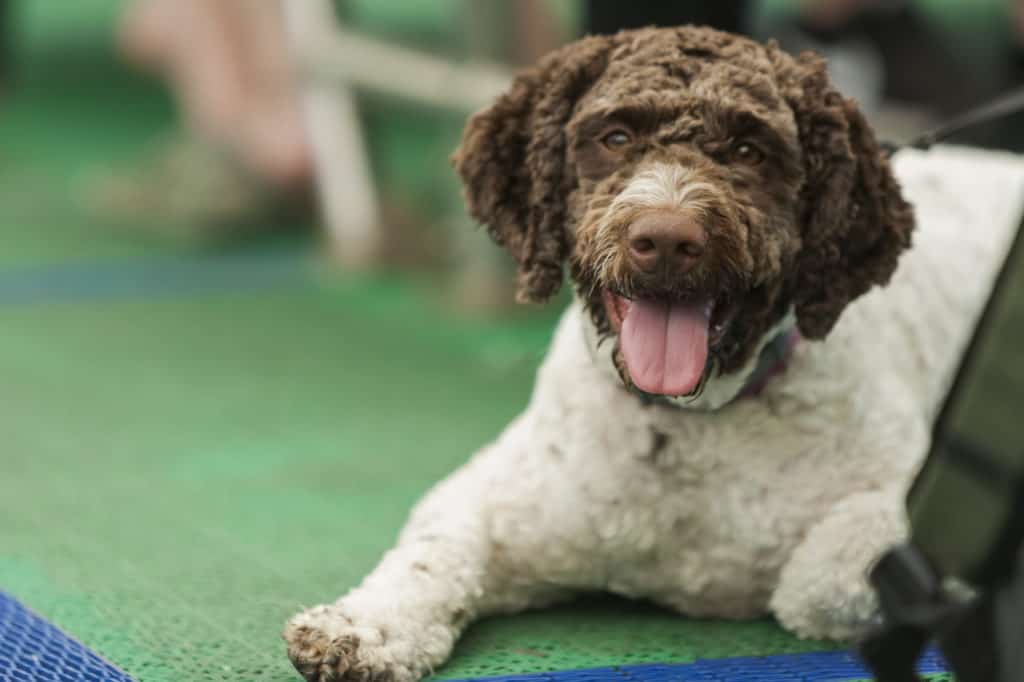
Barbets are described by the AKC as friendly, bright, and sweet-natured. With sufficient exercise, they are happy to settle down and be a quiet companion for their human roommate.
Size: 3/5
Barbets are medium-sized dogs, weighing 35-65 pounds and standing 19-24.5 inches tall.
Independence: 2/5
Barbets do not like to be alone for too long. They are loyal, affectionate, and sensitive dogs, but they are not considered Velcro dogs, so if they know you are in the apartment with them, they shouldn’t need to sit on your feet.
Noisiness: 3/5
Barbets are not known for being nuisance barkers, but they are not unlikely to bark if provoked or excited.
Shedding: 1/5
Barbets are infrequent shedders. Weekly brushing of their curly coat should prevent tangles and catch most loose hair before it is dropped out in your apartment.
Drooling: 1/5
Barbets are unlikely to drool, although their beards get wet while they drink and can drip water.
Energy level: 3/5
Barbets have moderate energy levels that can be satisfied with deliberate and regular exercise.
Exercise needs: 4/5
Barbets have moderate to high exercise needs. They should be taken out for a good exercise session for at least one hour every day.
Trainability: 4/5
While lacking the eagerness please that some gun dogs display, Barbets are nonetheless agreeable. This agreeableness means that you can train them relatively easily. But use positive training methods on these sensitive dogs.
Friendliness with strangers: 4/5
Your Barbet is not going to be best friends with everyone they meet, but they are not going to be reserved in their approach to non-threatening strangers.
Friendliness with other dogs: 4/5
Barbets who have been well-socialized should get along perfectly well with other dogs, provided the other dog is friendly too.
2. Clumber Spaniel
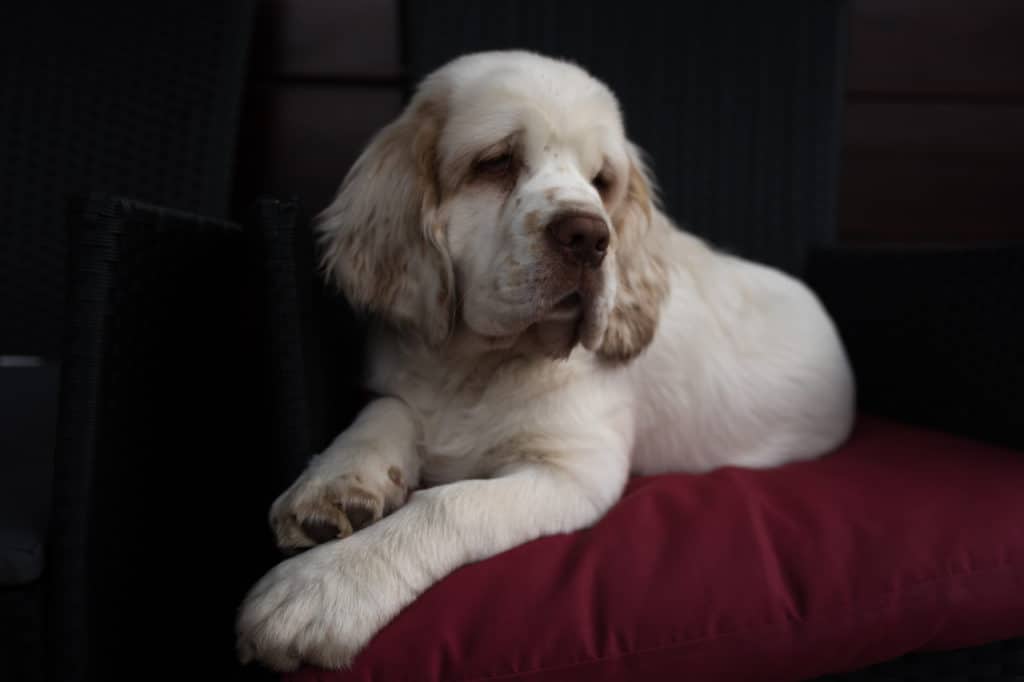
Clumber Spaniels are described by the AKC as mellow, amusing, and gentlemanly, making gentle companions for their human roommates.
Size: 3/5
Clumber spaniels are one of the biggest Spaniel breeds, weighing 55-85 pounds and standing 17-20 inches tall.
Independence: 2/5
Clumber Spaniels are laid back but not happy to be left alone for more than a few hours. They need encouragement to exercise, relying on you to provide them with the right amount of physical activity.
Noisiness: 1/5
Clumber Spaniels are not known for being particularly vocal. They might bark at the approach of a stranger, but your reassurance should settle them quickly.
Shedding: 5/5
Clumber Spaniels are heavy shedders. They only require weekly brushing, but you can increase this to try to control the amount of hair dropped in your apartment.
Drooling: 5/5
Clumber Spaniels have big, heavy jowls and are very prone to drooling.
Energy level: 2/5
Clumber Spaniels do not have the high-energy levels of most gun dogs, but they are not entirely sedentary. Their excess energy is more likely to manifest in stealing treats and food than tearing around the apartment.
Exercise needs: 3/5
Clumber Spaniels require 20-30 minutes of moderate daily exercise. Their exercise needs are not only linked to their energy levels but also to their health. They are heavy dogs whose weight needs to be carefully monitored and their joints kept healthy.
Trainability: 3/5
Clumber Spaniels are agreeable. However, they do need to be convinced that their training is necessary, so keep it exciting and avoid heavy-handed training techniques. Crate training is vital for Clumbers as they are happy (and able!) to counter surf and open cupboards, causing havoc while you are out.
Friendliness with strangers: 2/5
Clumber Spaniels are reserved with strangers but not aggressive. They will also warm up to them after a while.
Friendliness with other dogs: 4/5
Well-socialized Clumber Spaniels are friendly with other well-socialized dogs.
3. Cocker Spaniel
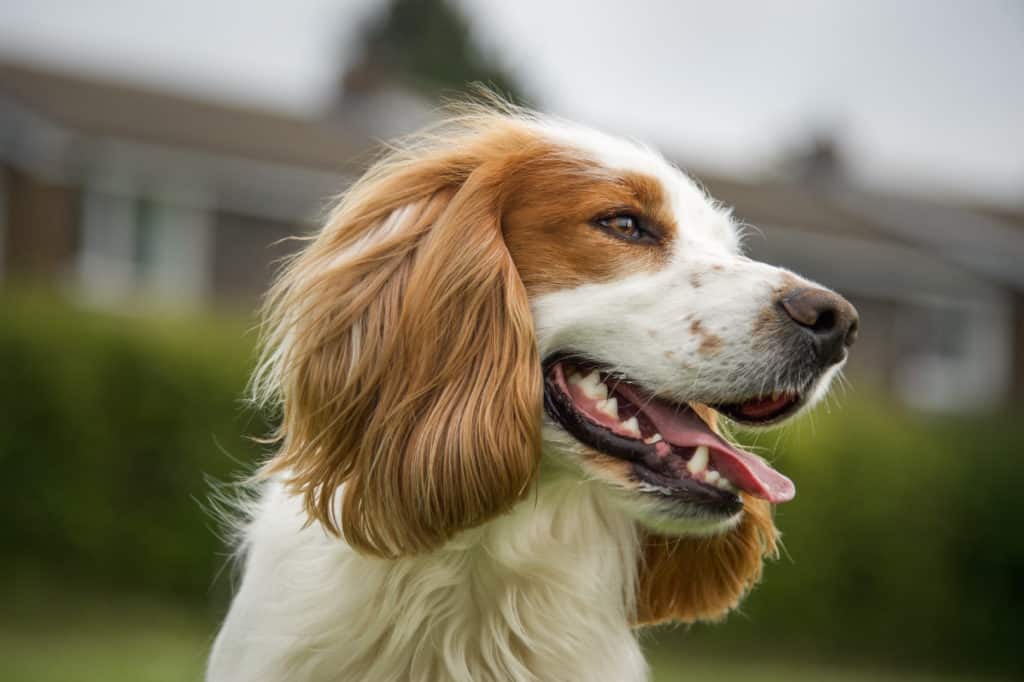
Cocker Spaniels are described by the AKC as gentle, smart, and happy. They are merry and delightful companions for apartment dwellers. Their noisiness is the biggest problem with apartment-living.
Size: 1/5
Cocker spaniels are the smallest working Spaniel breed, weighing 20-30 pounds and standing 13.5-15.5 inches tall.
Independence: 1/5
Cocker Spaniels are very intolerant of being left alone. They are highly affectionate and attach strongly to their humans, preferring activities that they can do with you to anything they can do alone.
Noisiness: 5/5
Cocker Spaniels are prone to excessive barking and require early and persistent training to try and overcome this fault. If they are left alone too long, Cockers will often become vocally distressed.
Shedding: 3/5
Cocker Spaniels are occasional shedders, but they do have a lot of hair and require dedicated and daily grooming.
Drooling: 2/5
Cocker Spaniels are unlikely to drool.
Energy level: 4/5
Cocker Spaniels are peppy dogs with moderate to high energy levels, but they are not very intense.
Exercise needs: 3/5
Cocker Spaniels need regular easy to moderate exercise. A 20- or 30-minute walk once or twice daily should be sufficient. They are also small enough to be able to get a small amount of exercise in the apartment.
Trainability: 5/5
Cocker Spaniels are smart and eager to please, an excellent combination for training.
Friendliness with strangers: 5/5
Cocker Spaniels love people and are very outgoing. Although they are not always great with kids, especially if they have not been raised with them, so be careful of small children running up to greet your cute doggy.
Friendliness with other dogs: 5/5
Cocker Spaniels are happy to make new dog friends at the dog park.
4. English Cocker Spaniel

English Cocker Spaniels are described by the AKC as energetic, merry, and responsive. They are entertaining and affectionate companions for apartment dwellers. Their noisiness can be problematic for apartment-living.
Size: 2/5
English Cocker spaniels are larger than their American counterparts, weighing 26-34 pounds and standing 15-17 inches tall.
Independence: 2/5
English Cocker Spaniels are human-orientated dogs. They prefer the company of their people and get very upset when left alone. They are inquisitive, though, so they will go off exploring. They are fine to leave you, but you are not allowed to leave them.
Noisiness: 5/5
English Cocker Spaniels are prone to nuisance barking and have a particular squealing sound for moments of great excitement. Unfortunately, English Cocker Spaniels are excited by a great many things.
Shedding: 2/5
English Cocker Spaniels are occasional shedders. Their highly feathered coats require regular grooming, which helps to keep the shedding in check.
Drooling: 3/5
Drooling is possible with English Cocker Spaniels, although they are more likely to salivate when they are waiting for their food.
Energy level: 4/5
English Cocker Spaniels have moderate to high energy levels. They can adapt to either moderately or very active owners.
Exercise needs: 4/5
English Cocker Spaniels need up to one hour of moderate to intense exercise every day. With too much excess energy, they can become destructive and noisy.
Trainability: 4/5
English Cocker Spaniels are intelligent and eager to please, but they do have a stubborn streak, so be firm and persistent in your training.
Friendliness with strangers: 4/5
English Cocker Spaniels are friendly with most people.
Friendliness with other dogs: 4/5
English Cocker Spaniels get along with other dogs, but they can be food aggressive if another dog approaches them while they are eating or chewing something that they consider is theirs.
5. Irish Water Spaniel
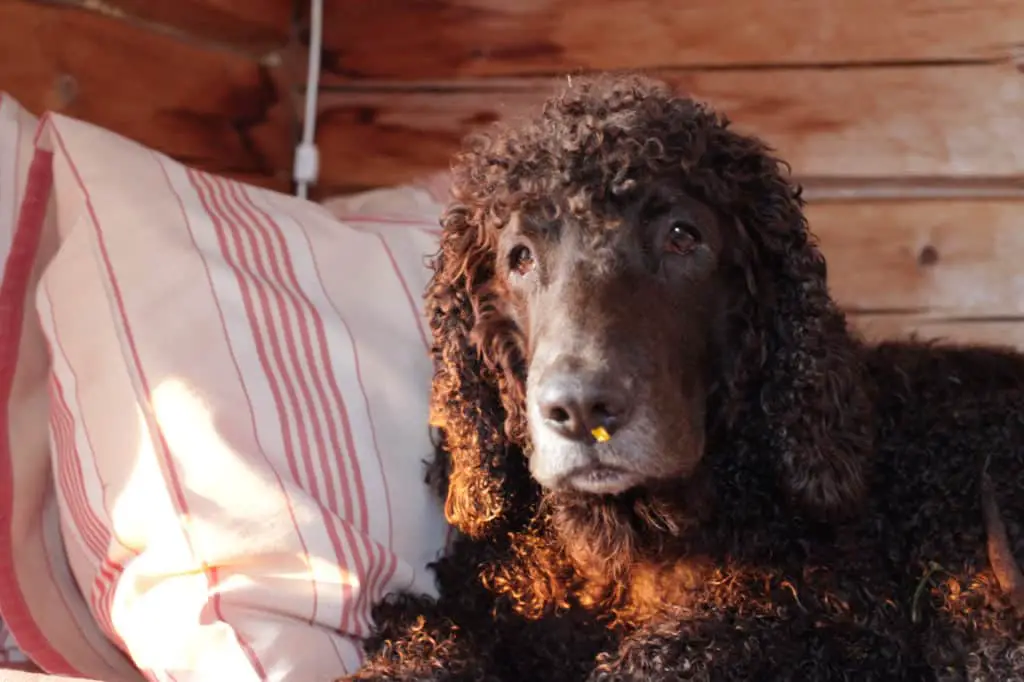
Irish Water Spaniels are described by the AKC as playful, hardworking, and brave. With sufficient exercise, they can make excellent apartment dogs for an active owner, but they are probably the least suited to apartment living out of all the dogs on our list.
Size: 4/5
The tallest Spaniels of the AKC, Irish Water Spaniels, stand 21-24 inches and weigh 45-68 pounds.
Independence: 4/5
Irish Water Spaniels are affectionate with their family, but they are independent dogs. If they are kept well exercised and entertained by their owners, they can happy live in a larger apartment.
Noisiness: 3/5
If an Irish Water Spaniel gets excited, they can vocalize, but otherwise, their barking seems to be limited to appropriate situations that trigger dogs to bark.
Shedding: 2/5
Irish Water Spaniels shed seasonally. By increasing the frequency of brushing during the changing seasons, you should be able to cope.
Drooling: 2/5
Irish Water Spaniels are unlikely to drool.
Energy level: 5/5
Irish Water Spaniels have high energy levels and need lots of activity during the day.
Exercise needs: 5/5
Irish Water Spaniels require at least 1-2 hours of intense exercise every day. They are perfect companions for runners, cyclists, and hikers because they have the strength and stamina to keep up.
Trainability: 4/5
Irish Water Spaniel are smart and learn quickly, but they are independent, which can lead to stubbornness, so you need to be patient and persistent in their training.
Friendliness with strangers: 2/5
Irish Water Spaniels are reserved with strangers. They will need extra training and extensive early socialization to help them deal with being out in public with lots of strangers. This reservation is not aggression, but people shouldn’t walk up to your dog expecting to be able to pet it.
Friendliness with other dogs: 3/5
Irish Water Spaniels are very friendly with dogs that they know but are not keen on strange dogs.
6. Nederlandse Kooikerhondje
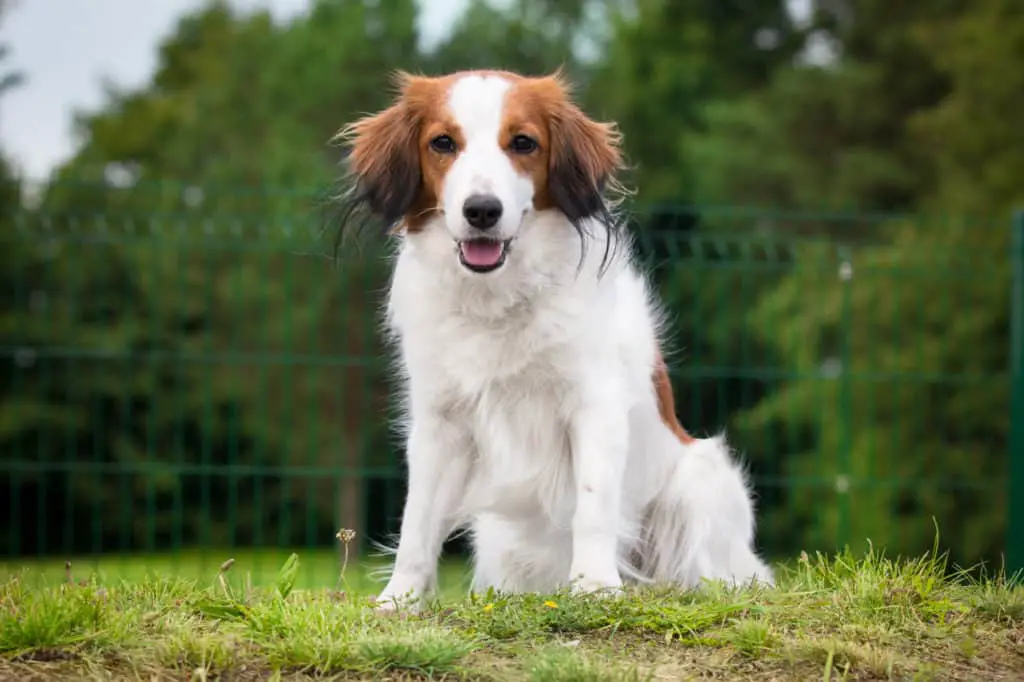
The Nederlandse Kooikerhondje is described by the AKC as friendly, alert, and quick. Cheerful and driven, they are excellent apartment roommates for confident owners.
Size: 2/5
The Nederlandse Kooikerhondje weighs 20-30 pounds and stands 14-17 inches.
Independence: 3/5
The Nederlandse Kooikerhondje loves his family but is strong-willed and confident.
Noisiness: 3/5
The Nederlandse Kooikerhondje is not known for being particularly noisy, but they are good watchdogs, sounding the alarm if need be.
Shedding: 2/5
The Nederlandse Kooikerhondje sheds seasonally. By increasing the frequency of brushing during the changing seasons, you should be able to cope.
Drooling: 1/5
The Nederlandse Kooikerhondje does not drool.
Energy level: 4/5
The Nederlandse Kooikerhondje has a moderate to high energy level and are quite intense dogs. They need confident owners who can match both their energy level and their strong-willed nature.
Exercise needs: 4/5
The intensity of the Nederlandse Kooikerhondje’s exercise requirements are adaptable to their owners, but if you reduce the intensity, you need to increase the duration. They need about an hour or moderate to intense exercise a day.
Trainability: 2/5
The Nederlandse Kooikerhondje is strong-willed, which can make training them a little challenging. However, they are also intelligent and eager to please, so just make sure you give them the right motivation.
Friendliness with strangers: 2/5
The Nederlandse Kooikerhondje is reserved with strangers but super friendly with friends and family, so make friends with your neighbors (the Kooikerhondje so personable, it should be easy), and with some people at the dog park.
Friendliness with other dogs: 2/5
The Nederlandse Kooikerhondje is also reserved with strange dogs but happy to play with those he knows.
7. Nova Scotia Duck Tolling Retriever
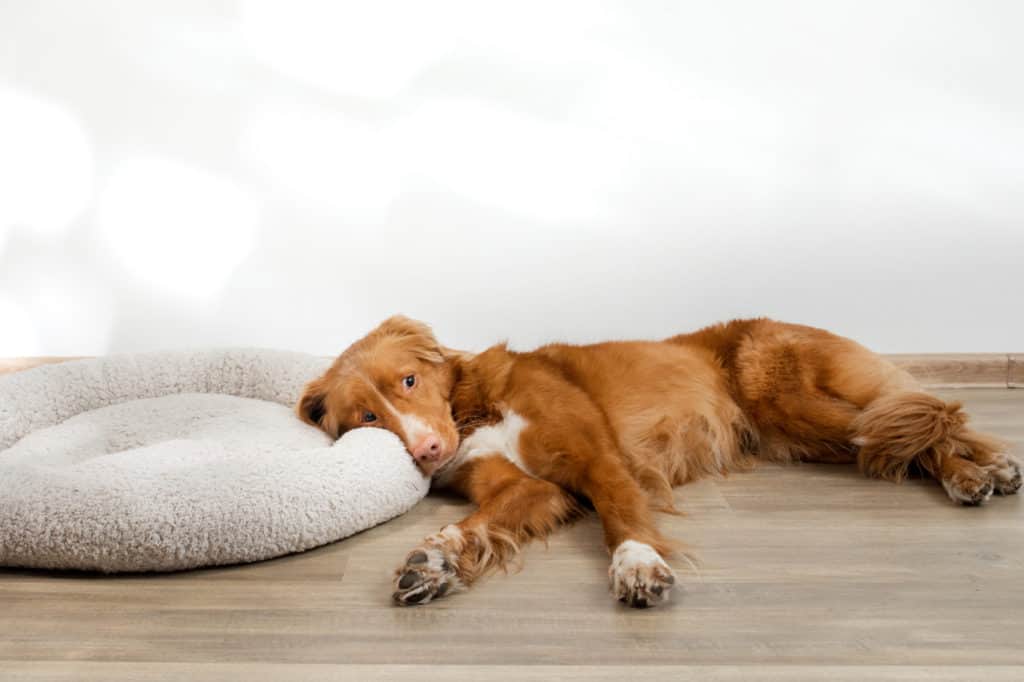
Nova Scotia Duck Tolling Retrievers are described by the AKC as affectionate, intelligent, and outgoing. With plenty of mental and physical exercise, they make great apartment companions for active owners.
Size: 3/5
Nova Scotia Duck Tolling Retrievers weigh 35-50 pounds and stand 17-21 inches tall.
Independence: 4/5
Nova Scotia Duck Tolling Retrievers are very affectionate but happy to be left alone for up to six hours if you give them a good exercise session beforehand.
Noisiness: 4/5
Noisiness can be a problem for Nova Scotia Duck Tolling Retrievers when they are left alone for longer than they can handle.
Shedding: 2/5
Nova Scotia Duck Tolling Retrievers shed seasonally. By increasing the frequency of brushing during the changing seasons, you should be able to cope.
Drooling: 1/5
Nova Scotia Duck Tolling Retrievers do not drool.
Energy level: 5/5
Nova Scotia Duck Tolling Retrievers are high-energy dogs with a tendency to be bouncy and jump up.
Exercise needs: 5/5
Nova Scotia Duck Tolling Retrievers require a minimum of one hour’s intense exercise a day. They are great companions for runners, cyclists, and hikers because they have the strength and stamina to keep up.
Trainability: 4/5
Nova Scotia Duck Tolling Retrievers are smart, but they need training needs to have a purpose. They love having jobs to do. Reward-based training methods are ideal because they are easier to train when they know it’s worth their while.
Friendliness with strangers: 4/5
Nova Scotia Duck Tolling Retrievers are not unfriendly, but they can be slightly reserved with complete strangers. They should not respond with aggression, however, and should warm up quickly.
Friendliness with other dogs: 5/5
Nova Scotia Duck Tolling Retrievers usually get along well with their fellow canines, especially those they know.
8. Spinone Italiano

The Spinone Italiano is described by the AKC as sociable, patient, and docile. With the right amount of exercise, they make great apartment companions.
Size: 4/5
The Spinone Italiano is on the larger side of medium, weighing 60-85 pounds and standing 22-27 inches tall.
Independence: 3/5
The Spinone Italiano is relatively independent while still being sensitive. They love their family but can be left on their own for longer than other gun dogs. They should not be kennel dogs, though.
Noisiness: 4/5
The Spinone Italiano is not a barking dog, but they are vocal and will chat and even yodel.
Shedding: 3/5
The Spinone Italiano is a moderate shedder. You will probably always find a few hairs, but you are unlikely to be snowed under, especially with adequate grooming.
Drooling: 4/5
The Spinone Italiano can be rather slobbery. Their beards also pick up water when they drink, so you will have dribbling around the water bowl.
Energy level: 3/5
The Spinone Italiano is actually only a moderate-energy dog compared to other gun dogs, but don’t mistake this for low energy. They are also not intense dogs, prone to clowning around rather than solemn thought.
Exercise needs: 4/5
Even though the Spinone Italiano has lower energy levels, they still require 1-2 hours of moderate exercise a day.
Trainability: 3/5
The Spinone Italiano is relatively easy to train but beware of their stubborn streak. Reward-based training methods are ideal because they are easier to train when they know it’s worth their while.
Friendliness with strangers: 4/5
The Spinone Italiano will let you know if a stranger is approaching, but they will quickly warm up to the stranger.
Friendliness with other dogs: 5/5
When well-socialized, the Spinone Italiano gets on well with other well-socialized dogs.
9. Sussex Spaniel
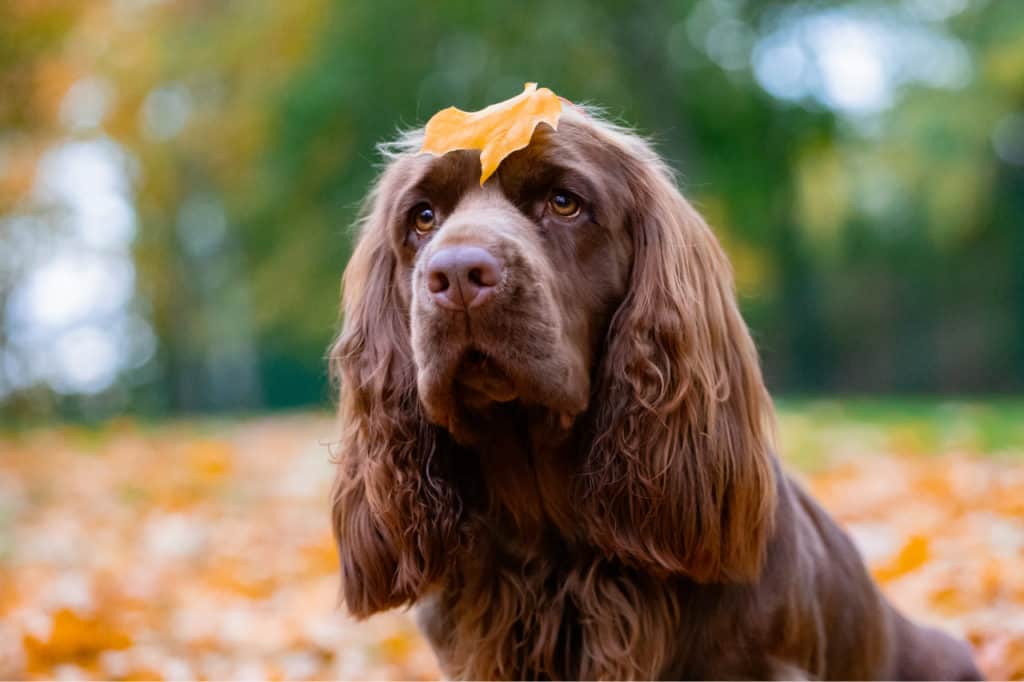
Sussex Spaniels are described by the AKC as friendly, merry, and even-tempered.
Size: 2/5
Short but stocky, Sussex Spaniels weigh 35-45 pounds and stand 13-15 inches tall.
Independence: 2/5
Sussex Spaniels are very attached to their owners and affectionate. They do not tolerate being left alone for a long time and will follow their humans around the apartment.
Noisiness: 4/5
Sussex Spaniels are not shy about barking, especially if they are displeased.
Shedding: 2/5
Sussex Spaniels shed seasonally. By increasing the frequency of brushing during the changing seasons, you should be able to cope.
Drooling: 3/5
Their drooping jowls make Sussex Spaniels potential droolers.
Energy level: 3/5
Sussex Spaniels have moderate energy levels.
Exercise needs: 3/5
Sussex Spaniels also have moderate exercise needs. A 20- to 30-minute walk every day should do the trick. The rest of their energy they can get out with self-exercise at home. Their smaller size means an apartment is sufficient to run off the last few beans.
Trainability: 2/5
Sussex Spaniels are tricky to train. They are easygoing but have a stubborn streak. They are also extremely sensitive and will remember any harsh treatment and become disinclined to cooperate.
Friendliness with strangers: 3/5
Sussex Spaniels can be reserved with strangers.
Friendliness with other dogs: 3/5
Sussex Spaniels can also be reserved with other dogs. A poorly socialized Sussex Spaniel can become over-protective of their family and act aggressively to strange dogs.
10. Welsh Springer Spaniel
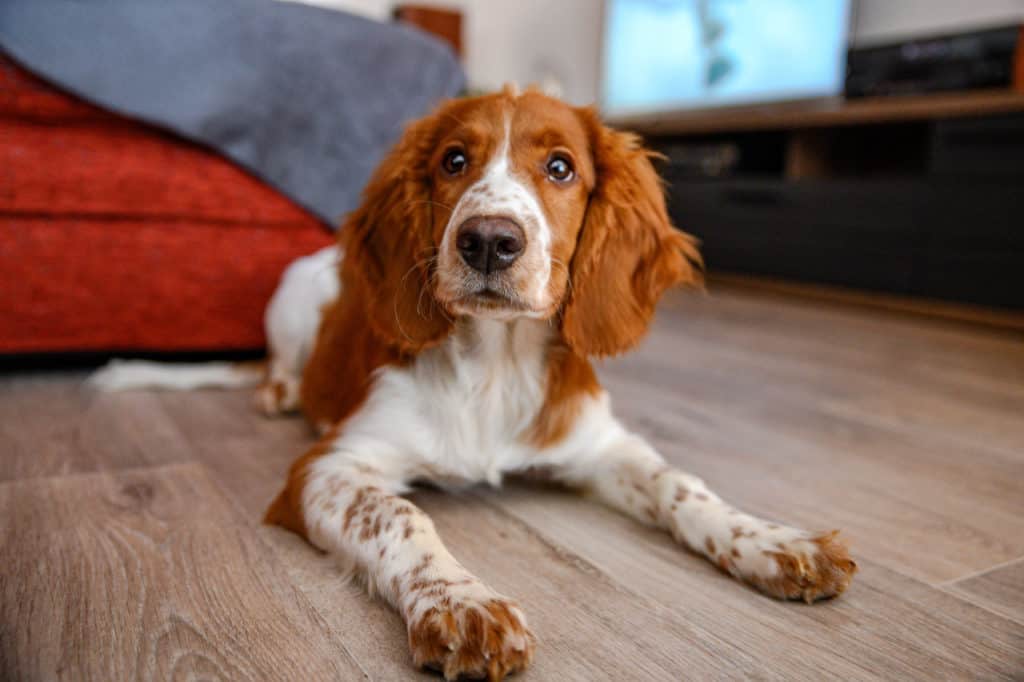
Welsh Springer Spaniels are described by the AKC as happy, reserved, and upbeat. With the right amount of exercise, they make fantastic apartment companions.
Size: 3/5
Welsh Springer Spaniels weigh 35-55 pounds and stand 17-19 inches tall.
Independence: 1/5
Welsh Springer Spaniels are sensitive and affectionate and do not like to be left alone for longer than an hour. Their focus is family, and without family, they become distressed.
Noisiness: 4/5
Welsh Springer Spaniels are prone to nuisance barking, especially if left alone for too long.
Shedding: 3/5
Welsh Springer Spaniels are moderate shedders. You will probably always find a few hairs, but you are unlikely to be snowed under, especially with adequate grooming.
Drooling: 2/5
Welsh Springer Spaniels are unlikely to drool.
Energy level: 4/5
Welsh Springer Spaniels are active, energetic, and relatively intense dogs that require not only sufficient physical exercise to be happy and manageable but also attention from and interaction with their owners.
Exercise needs: 5/5
Welsh Springer Spaniels require approximately two hours of exercise a day. They can join you on 4-5 mile runs, or you can take them for canine sports training and competitions.
Trainability: 4/5
Welsh Springer Spaniels are easy to train, although they can have a stubborn streak. Positive training techniques are a must for these sensitive dogs.
Friendliness with strangers: 2/5
Welsh Springer Spaniels are wary of strangers due to their well-developed protective instincts and territorialism.
Friendliness with other dogs: 4/5
Welsh Springer Spaniels generally get along well with other dogs unless they seem to be threatening their family.
Table Of Comparison
Using the comparison table below, you can select which traits are most important to you and pick the perfect apartment gun dog for you.
| Size | Independence | Noisiness | Shedding | Drooling | Energy Level | Exercise Needs | Trainability | Friendliness with strangers | Friendliness with dogs | |
| Ideal | 1/5 | 1/5 | 1/5 | 1/5 | 1/5 | 1/5 | 1/5 | 5/5 | 5/5 | 5/5 |
| Barbet | 3/5 | 2/5 | 3/5 | 1/5 | 1/5 | 3/5 | 4/5 | 4/5 | 4/5 | 4/5 |
| Clumber Spaniel | 3/5 | 2/5 | 1/5 | 5/5 | 5/5 | 2/5 | 3/5 | 3/5 | 2/5 | 4/5 |
| Cocker Spaniel | 1/5 | 1/5 | 5/5 | 3/5 | 2/5 | 4/5 | 3/5 | 5/5 | 5/5 | 5/5 |
| English Cocker Spaniel | 2/5 | 2/5 | 5/5 | 2/5 | 3/5 | 4/5 | 4/5 | 4/5 | 4/5 | 4/5 |
| Irish Water Spaniel | 4/5 | 4/5 | 3/5 | 2/5 | 2/5 | 5/5 | 5/5 | 4/5 | 2/5 | 3/5 |
| Nederlandse Kooikerhondje | 2/5 | 3/5 | 3/5 | 2/5 | 1/5 | 4/5 | 4/5 | 2/5 | 2/5 | 2/5 |
| Nova Scotia Duck Tolling Retriever | 3/5 | 4/5 | 4/5 | 2/5 | 1/5 | 5/5 | 5/5 | 4/5 | 4/5 | 5/5 |
| Spinone Italiano | 4/5 | 3/5 | 4/5 | 3/5 | 4/5 | 3/5 | 4/5 | 3/5 | 4/5 | 5/5 |
| Sussex Spaniel | 2/5 | 2/5 | 4/5 | 2/5 | 3/5 | 3/5 | 3/5 | 2/5 | 3/5 | 3/5 |
| Welsh Springer Spaniel | 3/5 | 1/5 | 4/5 | 3/5 | 2/5 | 4/5 | 5/5 | 4/5 | 2/5 | 4/5 |
Conclusion
The ideal apartment dog is small enough to live and move comfortably within the typically small space of an apartment and dependent enough on its owner not to suffer without space and freedom to be alone and exercise whenever they choose. They should also be as noiseless as possible to minimize neighbor complaints and relatively clean.
Manageable energy levels and exercise needs are a plus, as are trainability and eagerness to please, which ensure good inside manners and few toilet accidents. Finally, a good apartment dog knows how to get on with other people and dogs; their daily excursions out into public make this an indispensable trait to their happiness and yours.
Of course, very few dogs score perfectly in all categories of the ideal apartment dogs, and gun dogs seem unlikely to do well because of the traits and energy bred into them over centuries. However, the gun dogs listed in this article are moderately- to well-adapted for apartment living with the right owner.
References
https://www.akc.org/dog-breeds/barbet/
https://dogtime.com/dog-breeds/barbet#/slide/1
https://www.akc.org/dog-breeds/clumber-spaniel/
https://dogtime.com/dog-breeds/clumber-spaniel#/slide/1
https://www.orvis.com/clumber-spaniel
https://www.akc.org/dog-breeds/cocker-spaniel/
https://dogtime.com/dog-breeds/cocker-spaniel#/slide/1
https://www.orvis.com/cocker-spaniel
https://www.akc.org/dog-breeds/english-cocker-spaniel/
https://dogtime.com/dog-breeds/english-cocker-spaniel#/slide/1
https://www.orvis.com/english-cocker-spaniel
https://www.akc.org/dog-breeds/golden-retriever/
https://dogtime.com/dog-breeds/golden-retriever#/slide/1
https://www.orvis.com/golden-retriever
https://www.akc.org/dog-breeds/irish-water-spaniel/
https://www.akc.org/dog-breeds/irish-water-spaniel/
https://dogtime.com/dog-breeds/irish-water-spaniel#/slide/1
https://www.orvis.com/irish-water-spaniel
https://www.akc.org/dog-breeds/nederlandse-kooikerhondje/
https://dogtime.com/dog-breeds/kooikerhondje#/slide/1
https://www.akc.org/dog-breeds/nederlandse-kooikerhondje/
https://dogtime.com/dog-breeds/kooikerhondje#/slide/1
https://www.akc.org/dog-breeds/nova-scotia-duck-tolling-retriever/
https://dogtime.com/dog-breeds/nova-scotia-duck-tolling-retriever#/slide/1
https://www.orvis.com/nova-scotia-duck-tolling-retriever
https://www.akc.org/dog-breeds/spinone-italiano/
https://dogtime.com/dog-breeds/spinone-italiano#/slide/1
https://www.orvis.com/spinone-italiano
https://www.thekennelclub.org.uk/search/breeds-a-to-z/
https://www.akc.org/dog-breeds/sussex-spaniel/
https://dogtime.com/dog-breeds/sussex-spaniel#/slide/1
https://www.akc.org/dog-breeds/welsh-springer-spaniel/

